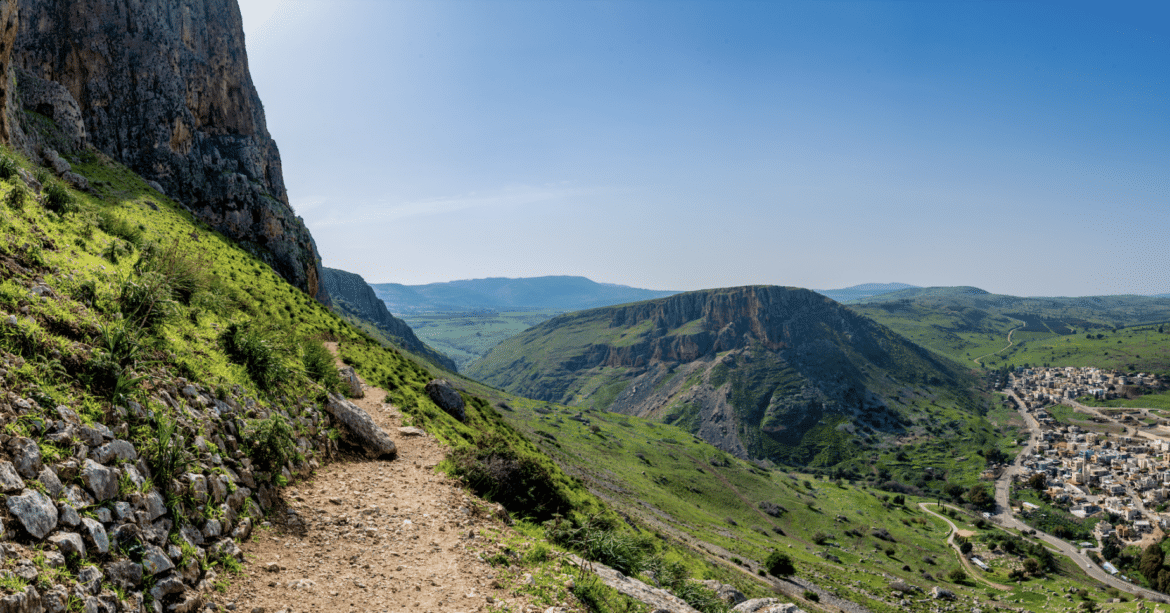Whether you’re planning to hike the entire diverse trail or explore select sections, these spots are not to be missed.
As Israel’s National Trail approaches its 30th anniversary next April, the iconic 1,040-kilometer (646-mile) path continues to captivate hikers and adventurers from around the globe.
Since its inauguration in 1995, this remarkable trek from Kibbutz Dan’s verdant north to Eilat’s sun-soaked shores has earned its place among the top hikes around the globe, offering an unparalleled journey through biblical landscapes and modern Israeli life.
What sets this trail apart is its dynamic nature and ability to adapt to Israel’s evolving landscape. The path, marked by distinctive white, blue, and orange painted stripes, has become more than just a hiking route – it’s a living testament to the country’s diversity, supported by a network of generous “trail angels” who offer refuge to weary trekkers.
As we celebrate this milestone, let’s explore 10 of the most breathtaking spots along this remarkable path, each offering its own unique window into Israel’s natural beauty and cultural heritage:
Mount Meron
As the highest peak in Israel (excluding the Golan Heights), Mount Meron offers stunning views of the Galilee region. The area is known for its beautiful forests, diverse wildlife and significance in Jewish mysticism as the resting place of Rabbi Shimon bar Yochai.
Mount Arbel
Offering panoramic views of the Sea of Galilee and the Golan Heights, Mount Arbel’s cliffside trail passes ancient caves and a historic fortress, combining natural beauty with fascinating history.
Ramat HaNadiv
Located near the city of Zichron Ya’akov, the Ramat HaNadiv nature park and gardens offer a serene escape with beautiful Mediterranean vegetation. The site also houses the graves of Baron Edmond de Rothschild and his wife, key figures in Israel’s early development.
Caesarea
As they pass through the ancient port city of Caesarea, hikers can marvel at the well-preserved Roman theaters, aqueducts and fortifications against the backdrop of the Mediterranean — and take some time to gawk at the ritzy neighborhoods just off the coastline.
Elah Valley
Step into biblical history as you traverse the Elah Valley, where David famously confronted Goliath. This area combines beautiful natural scenery with rich archeological sites, allowing hikers to connect with the land’s ancient past.
Ein Karem
This picturesque leafy neighborhood on the outskirts of Jerusalem offers a unique blend of religious significance and artistic charm. Known for its interfaith harmony, Ein Karem provides a peaceful respite and a glimpse into Jerusalem’s diverse cultural tapestry.
The Negev Desert
Stretching across southern Israel, the Negev offers hikers a chance to experience the raw beauty of the desert. From colorful sand dunes to ancient rock formations, this section of the trail provides a true wilderness experience.
HaMakhtesh HaKatan (The Small Crater)
This geological wonder is a prime example of Israel’s unique makhtesh formations: valleys of erosion found almost exclusively in the Negev and Sinai deserts. A wonderfully placed lookout point offers breathtaking vistas of this rare phenomenon, providing hikers with a gorgeous glimpse into Israel’s geological past.
The Dead Sea
A recent addition to the trail, the Dead Sea section allows hikers to experience the surreal beauty of the lowest point on Earth. Hikers may find it relaxing to float effortlessly in the mineral-rich waters and witness the unique desert landscape surrounding this natural wonder. Immersing yourself in that much saltwater is a surefire way of finding any cuts or scrapes you’ve picked up along the trail!
Eilat Mountains
The range of mountains in Israel’s southernmost reaches make for a scenic conclusion for many hikers’ treks. Standing among the peaks, you can enjoy a panoramic view of four countries before descending to the crystal-clear waters of the Red Sea.
What are you waiting for?
The beauty of the national trail is that it has such a wide spectrum of sights and vibes. There’s always a decent chance of finding a local stretch of it to hike on a day off, even if you can’t block out an entire two months of your schedule for it.
Tzippi Moss, the author of Angels & Tahina: 18 Lessons From Hiking the Israel Trail, recommends getting on the trail in any way that’s convenient to you.
“I think it’s wonderful that there’s a combination of nature and city on the trail,” she says. “I know it’s hard to take the time off for many people to do the entire thing, but especially since it’s the 30th anniversary, I would encourage anybody — whether they live here in Israel and have lived here most of their lives, or whether they’re tourists — to hike a part of the trail.”
Originally Posted on israel21c.org

